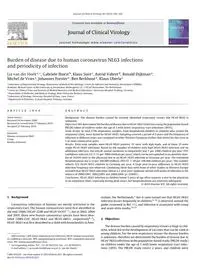
2010 Burden of disease due to human coronavirus NL63 infections and periodicity of infection PDF
Preview 2010 Burden of disease due to human coronavirus NL63 infections and periodicity of infection
Journal of Clinical Virology 48 (2010) 104–108 Contents lists available at ScienceDirect Journal of Clinical Virology journal homepage: www.elsevier.com/locate/jcv Burden of disease due to human coronavirus NL63 infections and periodicity of infection Lia van der Hoek a,∗, Gabriele Ihorst b, Klaus Sure c, Astrid Vabret d, Ronald Dijkman a, Michel de Vries a, Johannes Forster e, Ben Berkhout a, Klaus Uberla c a Laboratory of Experimental Virology, Department of Medical Microbiology, Center for Infection and Immunity Amsterdam (CINIMA), Academic Medical Center of the University of Amsterdam, Meibergdreef 15, 1105 AZ Amsterdam, The Netherlands b Center for Clinical Trials and Institute of Medical Biometry and Medical Informatics, University Hospital, Freiburg, Germany c Department of Molecular and Medical Virology, Ruhr-University Bochum, Germany d Laboratory of Virology, University Hospital of Caen, Caen, France e Department of Pediatrics, St Josefs Hospital, Freiburg, Germany a r t i c l e i n f o Article history: Received 18 December 2009 Received in revised form 17 February 2010 Accepted 27 February 2010 Keywords: Human coronavirus NL63 Croup Burden of disease a b s t r a c t Background: The disease burden caused by recently identified respiratory viruses like HCoV-NL63 is unknown. Objectives: We determined the burden of disease due to HCoV-NL63 infections using the population-based PRI.DE cohort of children under the age of 3 with lower respiratory tract infections (LRTIs). Study design: In total 1756 respiratory samples, from hospitalized children or children who visited the outpatient clinic, were tested for HCoV-NL63. Sampling covered a period of 2 years and the frequency of infection in different years was compared to other Western European studies that tested for this virus in 2 or more consecutive years. Results: Sixty-nine samples were HCoV-NL63 positive, 35 were with high loads, and of these 25 were single HCoV-NL63 infections. Based on the number of children with high HCoV-NL63 infection and no additional infection, the overall annual incidence in outpatients was 7 per 1000 children per year (95% confidence interval (CI) 3–13 per 1000 children per year), which can be extrapolated to an absolute num- ber of 16,929 visits to the physician due to an HCoV-NL63 infection in Germany per year. The estimated hospitalization rate is 22 per 100,000 children (95% CI: 7–49 per 100,000 children per year). This number reflects 522 HCoV-NL63 children in Germany per year. A large year-to-year difference in HCoV-NL63 infection frequency was observed. Combining these data with those of other studies in Western Europe revealed that HCoV-NL63 infections follow a 2-year inter-epidemic period with peaks of infection in the winters of 2000/2001, 2002/2003 and 2004/2005 (p < 0.0001). Conclusions: HCoV-NL63 infection in children below 3 years of age often requires a visit to the physician in an outpatient clinic, especially during peak-years, but hospitalizations are relatively infrequent. © 2010 Elsevier B.V. All rights reserved. 1. Background Coronavirus infections of humans are mostly restricted to the respiratory tract. The human coronaviruses were first identified in the mid 1960s (HCoV-229E and HCoV-OC431–3), but in 2003, 2004 and 2005, three new human coronavirus species have been iden- tified (SARS-CoV, HCoV-NL63 and HCoV-HKU1, respectively4–7). HCoV-NL63 was first described in a child with bronchiolitis in Ams- Abbreviations: LRTI, lower respiratory tract infection; HCoV, human coronavirus; CI, confidence intervals; NPS, nasopharyngeal secretions; RSV, respiratory syncytial virus; PIV, human parainfluenza virus. ∗ Corresponding author. Tel.: +31 20 5667510; fax: +31 20 6916531. E-mail address:
